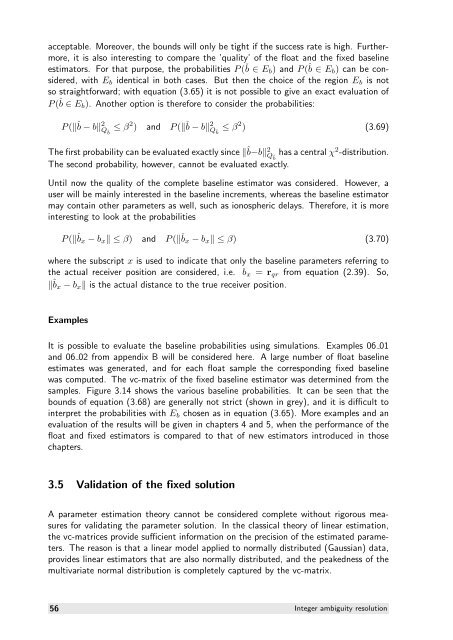The GNSS integer ambiguities: estimation and validation
The GNSS integer ambiguities: estimation and validation
The GNSS integer ambiguities: estimation and validation
You also want an ePaper? Increase the reach of your titles
YUMPU automatically turns print PDFs into web optimized ePapers that Google loves.
acceptable. Moreover, the bounds will only be tight if the success rate is high. Furthermore,<br />
it is also interesting to compare the ’quality’ of the float <strong>and</strong> the fixed baseline<br />
estimators. For that purpose, the probabilities P ( ˇ b ∈ Eb) <strong>and</strong> P ( ˆ b ∈ Eb) can be considered,<br />
with Eb identical in both cases. But then the choice of the region Eb is not<br />
so straightforward; with equation (3.65) it is not possible to give an exact evaluation of<br />
P ( ˆ b ∈ Eb). Another option is therefore to consider the probabilities:<br />
P ( ˆ b − b 2 Qˆ b ≤ β 2 ) <strong>and</strong> P ( ˇ b − b 2 Qˇ b ≤ β 2 ) (3.69)<br />
<strong>The</strong> first probability can be evaluated exactly since ˆb−b2 has a central χ Qˆb 2-distribution. <strong>The</strong> second probability, however, cannot be evaluated exactly.<br />
Until now the quality of the complete baseline estimator was considered. However, a<br />
user will be mainly interested in the baseline increments, whereas the baseline estimator<br />
may contain other parameters as well, such as ionospheric delays. <strong>The</strong>refore, it is more<br />
interesting to look at the probabilities<br />
P ( ˆ bx − bx ≤ β) <strong>and</strong> P ( ˇ bx − bx ≤ β) (3.70)<br />
where the subscript x is used to indicate that only the baseline parameters referring to<br />
the actual receiver position are considered, i.e. bx = rqr from equation (2.39). So,<br />
ˆ bx − bx is the actual distance to the true receiver position.<br />
Examples<br />
It is possible to evaluate the baseline probabilities using simulations. Examples 06 01<br />
<strong>and</strong> 06 02 from appendix B will be considered here. A large number of float baseline<br />
estimates was generated, <strong>and</strong> for each float sample the corresponding fixed baseline<br />
was computed. <strong>The</strong> vc-matrix of the fixed baseline estimator was determined from the<br />
samples. Figure 3.14 shows the various baseline probabilities. It can be seen that the<br />
bounds of equation (3.68) are generally not strict (shown in grey), <strong>and</strong> it is difficult to<br />
interpret the probabilities with Eb chosen as in equation (3.65). More examples <strong>and</strong> an<br />
evaluation of the results will be given in chapters 4 <strong>and</strong> 5, when the performance of the<br />
float <strong>and</strong> fixed estimators is compared to that of new estimators introduced in those<br />
chapters.<br />
3.5 Validation of the fixed solution<br />
A parameter <strong>estimation</strong> theory cannot be considered complete without rigorous measures<br />
for validating the parameter solution. In the classical theory of linear <strong>estimation</strong>,<br />
the vc-matrices provide sufficient information on the precision of the estimated parameters.<br />
<strong>The</strong> reason is that a linear model applied to normally distributed (Gaussian) data,<br />
provides linear estimators that are also normally distributed, <strong>and</strong> the peakedness of the<br />
multivariate normal distribution is completely captured by the vc-matrix.<br />
56 Integer ambiguity resolution
















